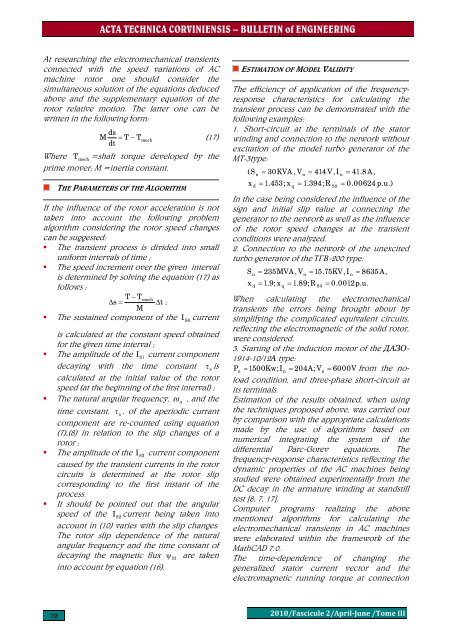ACTA TECHNICA CORVINIENSIS - Bulletin of Engineering
ACTA TECHNICA CORVINIENSIS - Bulletin of Engineering
ACTA TECHNICA CORVINIENSIS - Bulletin of Engineering
- No tags were found...
Create successful ePaper yourself
Turn your PDF publications into a flip-book with our unique Google optimized e-Paper software.
<strong>ACTA</strong> <strong>TECHNICA</strong> <strong>CORVINIENSIS</strong> – BULLETIN <strong>of</strong> ENGINEERINGAt researching the electromechanical transientsconnected with the speed variations <strong>of</strong> ACmachine rotor one should consider thesimultaneous solution <strong>of</strong> the equations deducedabove and the supplementary equation <strong>of</strong> therotor relative motion. The latter one can bewritten in the following form:dsM = T − T mech(17)dtWhere T mech=shaft torque developed by theprime mover; M =inertia constant.THE PARAMETERS OF THE ALGORITHMIf the influence <strong>of</strong> the rotor acceleration is nottaken into account the following problemalgorithm considering the rotor speed changescan be suggested:• The transient process is divided into smalluniform intervals <strong>of</strong> time ;• The speed increment over the given intervalis determined by solving the equation (17) asfollows :T − TΔ s =mech Δt;M• The sustained component <strong>of</strong> the IS0currentis calculated at the constant speed obtainedfor the given time interval ;• The amplitude <strong>of</strong> the IS1current componentdecaying with the time constant τaiscalculated at the initial value <strong>of</strong> the rotorspeed (at the beginning <strong>of</strong> the first interval) ;• The natural angular frequency, ωn, and thetime constant, τ a, <strong>of</strong> the aperiodic currantcomponent are re-counted using equation(7),(8) in relation to the slip changes <strong>of</strong> arotor ;• The amplitude <strong>of</strong> the IS2current componentcaused by the transient currents in the rotorcircuits is determined at the rotor slipcorresponding to the first instant <strong>of</strong> theprocess.• It should be pointed out that the angularspeed <strong>of</strong> the I S2current being taken intoaccount in (10) varies with the slip changes.The rotor slip dependence <strong>of</strong> the naturalangular frequency and the time constant <strong>of</strong>decaying the magnetic flux ψS1are takeninto account by equation (16).ESTIMATION OF MODEL VALIDITYThe efficiency <strong>of</strong> application <strong>of</strong> the frequencyresponsecharacteristics for calculating thetransient process can be demonstrated with thefollowing examples:1. Short-circuit at the terminals <strong>of</strong> the statorwinding and connection to the network withoutexcitation <strong>of</strong> the model turbo generator <strong>of</strong> theMT-3type:(Sxdn=30KVA , V= 1.453; xqn= 414 V, I= 1.394;RS0n= 41.8A,= 0.00624 p.u.)In the case being considered the influence <strong>of</strong> thesign and initial slip value at connecting thegenerator to the network as well as the influence<strong>of</strong> the rotor speed changes at the transientconditions were analyzed.2. Connection to the network <strong>of</strong> the unexcitedturbo generator <strong>of</strong> the ТГВ-200 type:Sxnd= 235MVA , V= 1.9; xqn= 1.89;R= 15.75KV, IS0n= 0.0012p.u.= 8635 A,When calculating the electromechanicaltransients the errors being brought about bysimplifying the complicated equivalent circuits,reflecting the electromagnetic <strong>of</strong> the solid rotor,were considered.3. Starting <strong>of</strong> the induction motor <strong>of</strong> the ДАЗО-1914-10/12А type:Pn = 1500Kw;In= 204A; Vn= 6000V from the noloadcondition, and three-phase short-circuit atits terminals.Estimation <strong>of</strong> the results obtained, when usingthe techniques proposed above, was carried outby comparison with the appropriate calculationsmade by the use <strong>of</strong> algorithms based onnumerical integrating the system <strong>of</strong> thedifferential Parc-Gorev equations. Thefrequency-response characteristics reflecting thedynamic properties <strong>of</strong> the AC machines beingstudied were obtained experimentally from theDC decay in the armature winding at standstilltest [8, 7, 17].Computer programs realizing the abovementioned algorithms for calculating theelectromechanical transients in AC machineswere elaborated within the framework <strong>of</strong> theMathCAD 7.0.The time-dependence <strong>of</strong> changing thegeneralized stator current vector and theelectromagnetic running torque at connection702010/Fascicule 2/AprilJune /Tome III
















